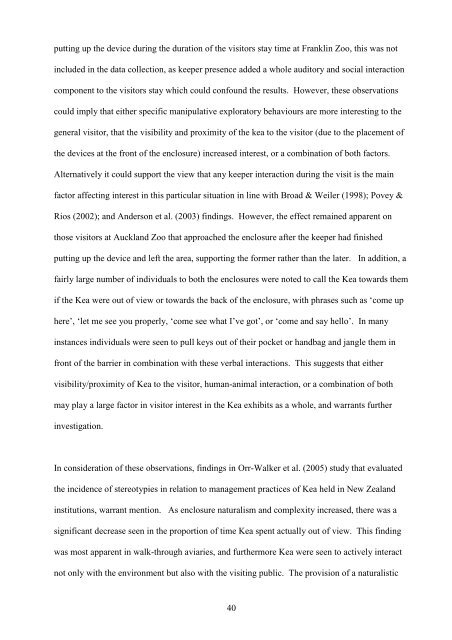The Dynamics of Kea Behaviour and Interpretive Signage on Visitor ...
The Dynamics of Kea Behaviour and Interpretive Signage on Visitor ...
The Dynamics of Kea Behaviour and Interpretive Signage on Visitor ...
You also want an ePaper? Increase the reach of your titles
YUMPU automatically turns print PDFs into web optimized ePapers that Google loves.
putting up the device during the durati<strong>on</strong> <str<strong>on</strong>g>of</str<strong>on</strong>g> the visitors stay time at Franklin Zoo, this was not<br />
included in the data collecti<strong>on</strong>, as keeper presence added a whole auditory <str<strong>on</strong>g>and</str<strong>on</strong>g> social interacti<strong>on</strong><br />
comp<strong>on</strong>ent to the visitors stay which could c<strong>on</strong>found the results. However, these observati<strong>on</strong>s<br />
could imply that either specific manipulative exploratory behaviours are more interesting to the<br />
general visitor, that the visibility <str<strong>on</strong>g>and</str<strong>on</strong>g> proximity <str<strong>on</strong>g>of</str<strong>on</strong>g> the kea to the visitor (due to the placement <str<strong>on</strong>g>of</str<strong>on</strong>g><br />
the devices at the fr<strong>on</strong>t <str<strong>on</strong>g>of</str<strong>on</strong>g> the enclosure) increased interest, or a combinati<strong>on</strong> <str<strong>on</strong>g>of</str<strong>on</strong>g> both factors.<br />
Alternatively it could support the view that any keeper interacti<strong>on</strong> during the visit is the main<br />
factor affecting interest in this particular situati<strong>on</strong> in line with Broad & Weiler (1998); Povey &<br />
Rios (2002); <str<strong>on</strong>g>and</str<strong>on</strong>g> Anders<strong>on</strong> et al. (2003) findings. However, the effect remained apparent <strong>on</strong><br />
those visitors at Auckl<str<strong>on</strong>g>and</str<strong>on</strong>g> Zoo that approached the enclosure after the keeper had finished<br />
putting up the device <str<strong>on</strong>g>and</str<strong>on</strong>g> left the area, supporting the former rather than the later. In additi<strong>on</strong>, a<br />
fairly large number <str<strong>on</strong>g>of</str<strong>on</strong>g> individuals to both the enclosures were noted to call the <str<strong>on</strong>g>Kea</str<strong>on</strong>g> towards them<br />
if the <str<strong>on</strong>g>Kea</str<strong>on</strong>g> were out <str<strong>on</strong>g>of</str<strong>on</strong>g> view or towards the back <str<strong>on</strong>g>of</str<strong>on</strong>g> the enclosure, with phrases such as ‘come up<br />
here’, ‘let me see you properly, ‘come see what I’ve got’, or ‘come <str<strong>on</strong>g>and</str<strong>on</strong>g> say hello’. In many<br />
instances individuals were seen to pull keys out <str<strong>on</strong>g>of</str<strong>on</strong>g> their pocket or h<str<strong>on</strong>g>and</str<strong>on</strong>g>bag <str<strong>on</strong>g>and</str<strong>on</strong>g> jangle them in<br />
fr<strong>on</strong>t <str<strong>on</strong>g>of</str<strong>on</strong>g> the barrier in combinati<strong>on</strong> with these verbal interacti<strong>on</strong>s. This suggests that either<br />
visibility/proximity <str<strong>on</strong>g>of</str<strong>on</strong>g> <str<strong>on</strong>g>Kea</str<strong>on</strong>g> to the visitor, human-animal interacti<strong>on</strong>, or a combinati<strong>on</strong> <str<strong>on</strong>g>of</str<strong>on</strong>g> both<br />
may play a large factor in visitor interest in the <str<strong>on</strong>g>Kea</str<strong>on</strong>g> exhibits as a whole, <str<strong>on</strong>g>and</str<strong>on</strong>g> warrants further<br />
investigati<strong>on</strong>.<br />
In c<strong>on</strong>siderati<strong>on</strong> <str<strong>on</strong>g>of</str<strong>on</strong>g> these observati<strong>on</strong>s, findings in Orr-Walker et al. (2005) study that evaluated<br />
the incidence <str<strong>on</strong>g>of</str<strong>on</strong>g> stereotypies in relati<strong>on</strong> to management practices <str<strong>on</strong>g>of</str<strong>on</strong>g> <str<strong>on</strong>g>Kea</str<strong>on</strong>g> held in New Zeal<str<strong>on</strong>g>and</str<strong>on</strong>g><br />
instituti<strong>on</strong>s, warrant menti<strong>on</strong>. As enclosure naturalism <str<strong>on</strong>g>and</str<strong>on</strong>g> complexity increased, there was a<br />
significant decrease seen in the proporti<strong>on</strong> <str<strong>on</strong>g>of</str<strong>on</strong>g> time <str<strong>on</strong>g>Kea</str<strong>on</strong>g> spent actually out <str<strong>on</strong>g>of</str<strong>on</strong>g> view. This finding<br />
was most apparent in walk-through aviaries, <str<strong>on</strong>g>and</str<strong>on</strong>g> furthermore <str<strong>on</strong>g>Kea</str<strong>on</strong>g> were seen to actively interact<br />
not <strong>on</strong>ly with the envir<strong>on</strong>ment but also with the visiting public. <str<strong>on</strong>g>The</str<strong>on</strong>g> provisi<strong>on</strong> <str<strong>on</strong>g>of</str<strong>on</strong>g> a naturalistic<br />
40












